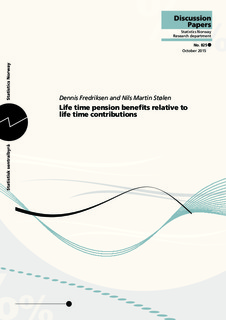| dc.description.abstract | Over the life course members of an insurance system normally will contribute by payments when in working age, and later receive pension benefits as e.g. disabled or old-age pensioners. Total expected discounted contributions from labour market earnings may be compared to the expected discounted sum of benefits from pensions received. The first cohorts covered with benefits from a pay-as-you go pension system will normally receive higher benefits than what follows from their contributions.
Reforms of the pension system may also affect the ratio between discounted life time pension benefits and discounted life time contributions. In Norway the former National Insurance Scheme was introduced in 1967, and a reform of this system has been implemented from 2011. Budgetary and distributional effects are analysed by the dynamic micro simulation model MOSART. The aim of this paper is to analyse the distributional consequences between generations from implementation of the system in 1967 and the reform from 2011. Problems arising in this kind of analyses are discussed, and effects are presented for different groups of the population by birth cohort, gender, education and for natives versus immigrants.
As expected the results show that the cohorts who established the pay-as-you-go system experienced a substantial gain by letting future generations pay. For later cohorts discounted value of benefits received is lower than the discounted value of contributions. With a positive net rate of interest the value of contributions as young is more worth than the corresponding value of benefits received as old. Over the life course the pension system distributes incomes from men to women, but women are more affected by the pension reform in 2011 than men. | en |
